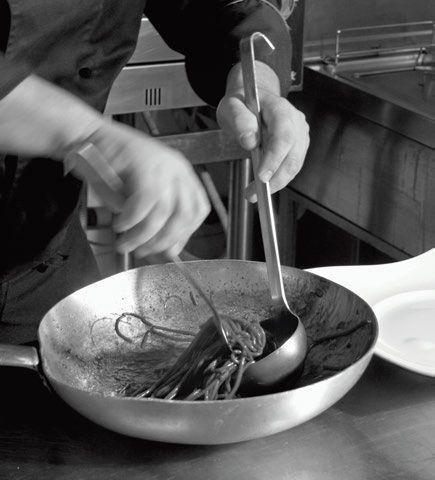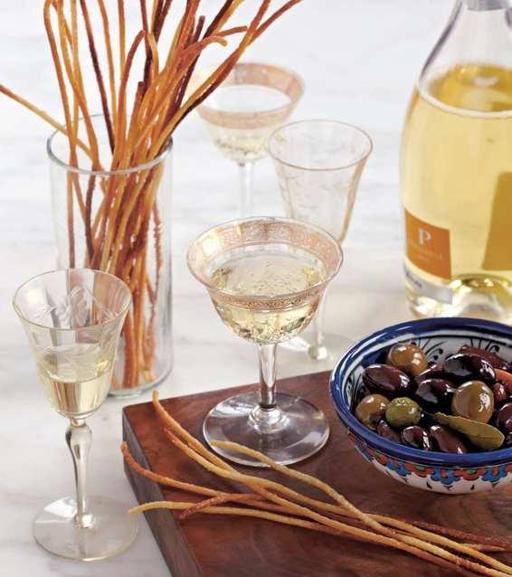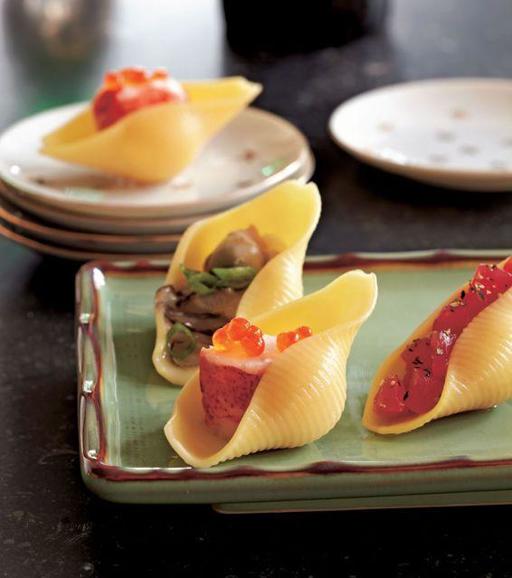Pasta Modern (4 page)
Authors: Francine Segan

SPICES AND SALT:
Use only freshly grated whole nutmeg and freshly ground black pepper. It makes a world of difference in taste and aroma. For the table or to garnish certain dishes like
Pasta-Wrapped Shrimp
you might like to try a pretty snowflake-like salt called flaked salt or one of the many types of specialty gourmet salts infused with smoke, red wine, or bits of truffles.
Avere sale in zucca
.
He has salt on his pumpkin.

FINE-TUNING YOUR PASTA-COOKING SKILLS
1
Preparation
Pasta must “swim like a fish in the ocean,” say the Italians.
So, use a big pot so the pasta has room to move while it cooks.
Think horizontally when cooking small amounts or filled pasta.
When making long pasta like spaghetti for just one person, Italians put it into a wide, shallow pan. You need only fill the pan with enough water to cover the spaghetti horizontally, not vertically! Cook ravioli and other filled pasta in a wide, shallow pan as well, so it jostles less than it would in deep water. If making many portions, use two pans. And to avoid breaking the ravioli, lift them out of the water with a slotted spoon instead of straining them in a colander.
Start with cold water, not hot,
as hot water passes through different pipes and picks up more impurities. Use at least 1 quart (approximately 1 L) for every 4 ounces (115 grams) of pasta.
Never put oil in the water.
It prevents the pasta from releasing its starch and absorbing the sauce.
Do not add the pasta or the salt until the water boils.
The water must be rapidly boiling before you put in the pasta, otherwise the pasta becomes gummy. Add the salt after the water boils so it doesn’t settle at the bottom of the pot. How much salt to add is up to your personal taste.
2
Cooking the Pasta
Use the time on the package only as a general guideline.
The ideal cooking time will vary due to personal preferences, amount of water in the pot, and many other factors. The best way to tell if pasta is ready is to taste it. Start tasting 3 to 4 minutes before the suggested cooking time on the package.
Never leave pasta unattended.
“Pasta suffers if it’s lonely,” says Riccaro Felicetti, president and fourth-generation owner of Pastificio Felicetti. You need to be near the boiling pot to give it the occasional stir so the pasta doesn’t stick. “Pasta has been around for centuries; it should be respected. Give it your time and your attention,” Felicetti stresses.
Never rinse pasta.
The starch on the pasta helps sauces adhere to it, and is a thickening agent for the sauce, too.
Always save a little of the pasta cooking water
to toss with the pasta and sauce to thicken and meld the flavors. Again, it’s that starch that helps bring everything together.
3
Finishing the Dish
The absolute cardinal rule and single most important technique for making perfect pasta is to
finish cooking the pasta in the sauce.
Italians call it
saltare in padella
—jumping in the pan—which allows the sauce to thicken and the flavors to meld, as the natural starch in the pasta acts as a thickening and binding agent. I’ve added it to the instructions for virtually every recipe. It’s an important step, so please don’t skip it.
There is no “right” pasta for a particular sauce,
but generally short pasta is best paired with thick, full-flavored sauces. Thinner, lighter sauces, like those made with fresh tomatoes, go best with long thin pasta, like spaghetti. Throughout the book, I suggest either long or short where applicable and when it truly doesn’t matter I’ve written “any pasta.” If I mention a particular shape in the ingredient list, it’s just a suggestion to pique your curiosity, so by all means use whatever shape tickles your fancy. All the shapes I reference are in the photo glossary at the end of the book (see
this page
).
Learn to play with fire!
Il fuoco fa il buon cuoco
—fire makes the chef—meaning that knowing when to raise or lower the flame is the key to good cooking. Adjust the heat and flame levels to create rich, multileveled flavors. Don’t be afraid to add heat; just keep a close eye and stir constantly when using high temperatures. When you cook pasta risotto-style, right in the sauce, like
Fish Heads, Fish Heads
, remember to raise the heat to high at the end of cooking to thicken the sauce. It’s especially important to finish on high heat any pasta dishes that feature a wine or a vegetable or fruit-juice glaze, like
Pasta with Caramelized Oranges
and
Spaghetti in Red Wine
. Similarly, play with low heat. Some sauces, like
Slow-Simmered Tuna, Caramelized Onions & “Candles”
are best cooked over extremely low temperatures, what many Italians refer to as “cooking by candlelight.” Start the onions on low heat until they release moisture, then slowly raise the heat and finish cooking them on high for a deep caramelized flavor.
PASSIVE PASTA
There’s been a lot of buzz in Italy in the past few years about
cottura passiva
—cooking pasta in boiling water for just two minutes, then covering the pot and turning off the heat as it continues to cook “passively” until it is al dente. This nontraditional technique, which is thought to keep in precious starch and gluten, has caused quite a stir on Italian Web forums and in newspapers and magazines.
Many Italians swear by “passive cooking,” so I recommend that you try it, at least once. I find it’s an especially good technique for delicate or intricately shaped pasta that might get broken in rapidly boiling water.


Appetizers & Soups
A TAVOLA NON S’INVECCHIA.
AT THE TABLE ONE DOESN’T AGE.
In today’s Italy, pasta is served in all sorts of new and exciting ways, not only as the traditional first course to a seated meal. Popular in Italy is a new trend called
apericena
or
aperitivo cenato
, appetizers as dinner: an assortment of tiny plates served in lieu of dinner. Hip restaurants and bars present elaborate buffets, with many lush pasta offerings, like
Gooey Mozzarella Sliders
, included free with the price of a glass of wine or cocktail. Creative finger foods like
Pasta Pretzel Sticks
(pictured on previous page),
Pasta-Wrapped Shrimp
, and
Award-Winning Macaroni Fritters
are nibbled at bars, at cocktail parties, on picnics, or at the beach, or are taken to work for lunch. In fact, several of the appetizers in this chapter are so simple to make and fun to eat that I’ve used the nontraditional “serves as many as you like” format—this way you can easily adjust the recipe to serve one, ten, or a hundred people!

SERVES
as many as you’d like
|
REGION:
Throughout Italy
Italy’s amazingly creative two–Michelin-star chef Davide Scabin invented “pasta sushi” a few years ago by substituting pasta shells for white rice, making beautiful, Japanese-inspired but Italian-flavored, one-bite appetizers. Genius!
He seasons the shells with a splash of rice vinegar and a few drops of mirin, a sweet Japanese rice wine, then lets his imagination rip, filling the shells with any sort of seafood, cooked or raw, garnished in myriad ways. Try poached lobster topped with caviar, diced tuna, or a raw oyster—or create your own. You can fill them all the same, or make an assortment; just calculate about four pasta shells per serving and a heaping tablespoon of filling for each.
Chef Scabin loves the idea because it showcases how versatile Italian pasta is and how easily it crosses over into other cuisines. I love it because now I can make my own Italian-style sushi at home in minutes!
FOR THE SHELLS:
4 large pasta shells per person, preferably Felicetti brand
Salt
Rice wine vinegar or lemon juice, to taste
Mirin, sweet Marsala, or sherry, to taste
FOR THE FILLING:
Diced or thinly sliced raw fish, such as tuna or salmon; raw or cooked oysters; sea urchin; caviar; and/or cooked fish like poached lobster, crab, or shrimp
FOR THE GARNISH:
Lemon or orange zest; grated horseradish; chopped scallions; diced fresh fruit;
burrata
or other cheese; red chili pepper; and/or sea salt
Boil the pasta in salted water until it is al dente. Drain and toss with a splash, to taste, of rice wine vinegar and mirin. Spread the shells out onto a plate and let them cool to room temperature.
Fill each shell with 1 tablespoon filling. Garnish to taste, season as you like, and serve immediately.PASTA PRETZEL STICKS
{
Pasta croccante
}
SERVES
4
to
6
|
REGION:
Throughout Italy
Other books
Willowleaf Lane by Thayne, RaeAnne
Golden [Bedtime stories 1] by Joyee Flynn
Desert Wives (9781615952267) by Webb, Betty
Beauty and the Billionaire (BILLIONAIRE BOYS CLUB NOVEL) by Clare, Jessica
A Run for Love by Callie Hutton
Killing Me Softly by Leisl Leighton
Tenth Commandment by Lawrence Sanders
The Boy's Tale by Margaret Frazer
El evangelio según Jesucristo by José Saramago
The Shadows of Ghadames by Joelle Stolz
